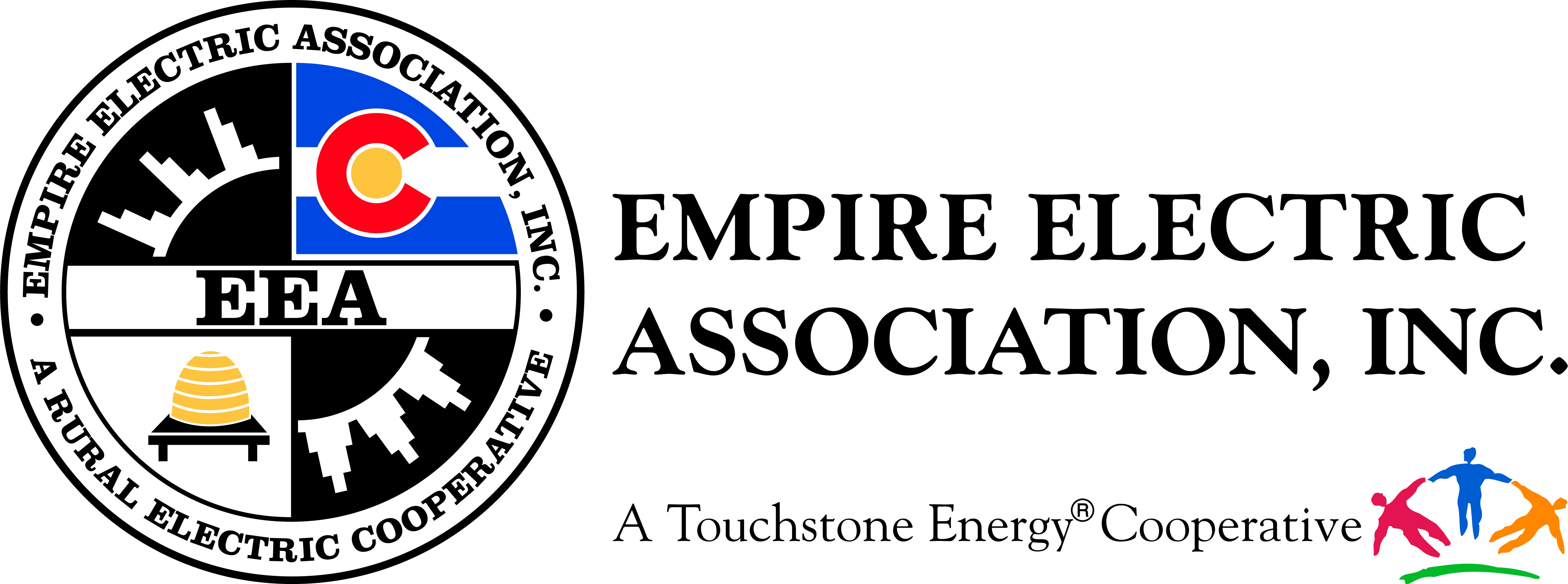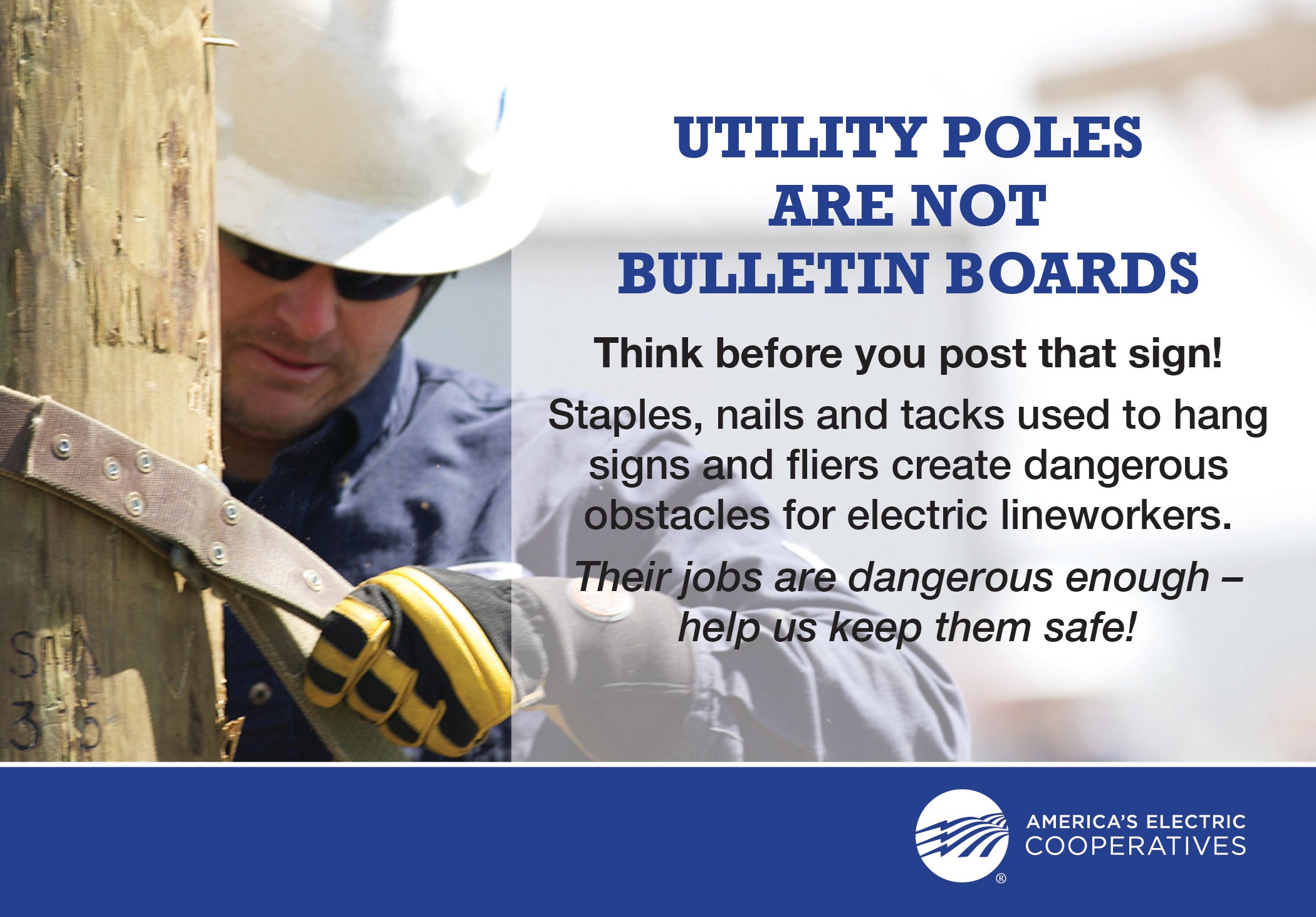Safety is a priority
for our employees and our members.
Accidentally contacting a power line can be dangerous and in some cases, even deadly. EEA wants to help members stay safe around power lines. Whether you are playing outdoors with your children or working on landscaping projects, keep a safe distance from power lines and other equipment that EEA uses to provide electricity to your home.
Always remember to:
- Stay away from power lines, meters, transformers and electrical boxes.
- Don’t climb trees near power lines.
- Never fly kits, remote control airplanes or balloons near power lines.
- If you get something stuck in a power line, call EEA.
- Keep a safe distance from overhead power lines when working with ladders.
- Never touch or go near a downed power line.
- Don’t touch anything that may be touching a downed wire.
- Keep children and pets away.
If a power line falls on a car, you should stay inside the vehicle. This is the safest place to stay. Warn people not to touch the car or the line. Call or ask someone to call EEA at (970) 565-4444 and emergency services at 911.
The only circumstance in which you should consider leaving a car that is in contact with a downed power line is if the vehicle catches on fire. Open the door. Do not step out of the car. You may receive a shock. Instead, jump free of the car so that your body clears the vehicle before touching the ground. Once you clear the car, shuffle at least 50 feet away, with both feet on the ground.
Do not try to help someone else from the car while you are standing on the ground unless an EEA lineman has ensured the line is de-energized..
Preventing Electrocutions Associated with Portable Generators Plugged Into Household Circuits
When power lines are down, residents can restore energy to their homes or other structures by using another power source such as a portable generator. If water has been present anywhere near electrical circuits and electrical equipment, turn off the power at the main breaker or fuse on the service panel. Do not turn the power back on until electrical equipment has been inspected by a qualified electrician.
If it is necessary to use a portable generator, manufacturer recommendations and specifications must be strictly followed. If there are any questions regarding the operation or installation of the portable generator, a qualified electrician should be immediately contacted to assist in installation and start-up activities. The generator should always be positioned outside the structure.
When using gasoline- and diesel-powered portable generators to supply power to a building, switch the main breaker or fuse on the service panel to the "off" position prior to starting the generator. This will prevent power lines from being inadvertently energized by backfeed electrical energy from the generators, and help protect utility line workers or other repair workers or people in neighboring buildings from possible electrocution. If the generator is plugged into a household circuit without turning the main breaker to the “off” position or removing the main fuse, the electrical current could reverse, go back through the circuit to the outside power grid, and energize power lines or electrical systems in other buildings to at or near their original voltage without the knowledge of utility or other workers.
Back Feed and Other Hazards
The problem of back feed in electrical energy is a potential risk for electrical energy workers. Electrocutions are the fifth leading cause of all reported occupational deaths.
Generator use is also a major cause of carbon monoxide (CO) poisoning. Generators should only be used in well ventilated areas.
Colorado law requires underground utilities to be located BEFORE anyone digs. Whether you are a contractor working on a site or a homeowner working around your own home, digging can be dangerous if you don't check for underground wiring, cable or other underground utilities such as natural gas, water, or sewer lines.
Call the Utility Notification Center of Colorado at 811 or log on to co811.org at least three days before you plan to dig and they will locate all underground utilities on your property at no cost to you. Want to avoid spending a day in the dark? It's as simple as 8-1-1. If residing in Utah call 1-800-662-4111 or log on to www.bluestakes.org.
Your call will be routed to your local One Call Center. Tell the operator where you're planning to dig, what type of work you will be doing and your affected local utilities companies will be notified about your intent to dig. In a few days, they'll send a locator to mark the approximate location of your underground lines, pipes and cables, so you'll know what's below - and be able to dig safely.
Remember; always call 811 before you start any digging project! You'll avoid injury, expense, embarrassment - and a very inconvenient day in the dark.
Electrical Wiring Inspections
EEA cannot provide electrical service to new construction, remodeling or mobile home applicants until a licensed inspector has inspected all wiring and installations on the applicant's side of the meter and all buried wiring has been properly backfilled. In Colorado, inspections are done by the State Electrical Inspector. You may contact the Inspector at (303) 869-3457 or toll-free at (855) 451-9794, or find more information through the Department of Regulatory Agencies.
If an electrical permit is required, contact the Colorado State Electrical Board (1-303-894-2300) or Utah Building Inspector (1-435-587-3221). EEA has the permit applications available at the Engineering and Operations facility located at 23999 Road L.4, Cortez, Colorado, 81321.
National Electrical Code
All customers' electrical wiring and equipment must meet NEC requirements. A copy of the code can be reviewed in EEA’s Engineering and Operations facility located at 23999 Road L.4, Cortez, Colorado.
National Electrical Safety Code
EEA is obligated to construct electric power lines and services in such a way as to guard the public and our own employees from physical and electrical hazards. NESC spells out specific measures that define clearances of wire to ground, wire to wire, wire to building, physical strength of poles and other line supports and safe ground cover depths over underground lines.
Easement Encroachment
All electric line routes, whether overhead or underground, have an implied or well-defined "clear zone" or easement area that is legally protected from specific activities that may hamper safe operation and maintenance of, or access to, electric lines.
Ten Foot Rule
If work is to be performed within 10 feet of high voltage overhead lines, EEA must be contacted at 970-565-4444 or 1-800-709-3726 to arrange for safety provisions. This law applies to any person or business contracting to do work or perform any activity which may bring an individual or piece of equipment within 10 feet of high voltage overhead lines. Violations of this rule may result in state sanctioned fines.
Excavation Notification
Anyone requiring excavation must have all underground facilities located and inform the excavation contractor of all existing underground facilities. This law applies to any person or business contracting to do work or perform any activity which may require excavation. Two (2) business days advance notice is required before excavation work is performed. In Colorado call 1-800-922-1987 or visit Call Before You Dig - 811; in Utah call 1-800-662-4111 or log on to www.bluestakes.org.
Meter Tampering
Theft of electricity is a violation of State Law and persons found tampering with their electric meter will be prosecuted.
-
Have a licensed, qualified heating technician service your furnace or heating system.
-
Change heating system filters to keep air passing through.
-
Replace batteries in your smoke detectors and carbon monoxide alarms.
-
Don’t use electrical appliances around wet areas like bathtubs or sinks.
-
Dry your hands before using electrical appliances.
-
Keep electric heaters on level surfaces and 6-8 feet from furniture, curtains and drapes.
Although EEA is providing state of the art utility surge protection, no equipment is available that we can install on our lines to protect your sensitive loads. Adequate protection can only be obtained by applying power conditioning equipment near the load to be protected — which means on the customer's premises. Given the fact that potentially harmful power disturbances exist and that EEA cannot protect your sensitive equipment from these irregularities, the choice to protect or not to protect your equipment falls on you.
Power quality protection equipment can be viewed much like insurance. One should be careful in deciding what the true costs of operating without protection may be. The most obvious cost is the potential for damage to the sensitive equipment in your home or business. Consider the potential cost from loss of important data or business operations. Failure of your business phone system or electronic cash register can cause temporary inability to conduct business.
Just as with insurance, different power quality protection equipment is available to cover different risks and many levels of coverage are available. Generally, better protection is more expensive. There are a number of different types of protective equipment available including transient impulse suppressers (most commonly used with personal computers), line conditioners, secondary arresters, and uninterruptible power supplies.
If you have power quality problems, EEA can help you determine what problems may exist at your location and what solutions make sense for your home or business. Contact EEA's Member Services at 565-4444 or 1-800-709-3726 for assistance.
You can help us out by reporting electric power line conditions that need attention such as:
-
Poles that are broken or leaning
-
Wires sagging too low or broken
-
Trees growing into the line
-
Broken insulators
-
Sparks coming from electrical wires or equipment
-
Excavation activity in areas where buried lines are likely to exist
-
Construction activity under power lines
-
If you see a problem, please let us know. EEA wants to keep electric lines in good shape to give you the best and most reliable service.
24 hours a day call 970-565-4444 or 1-800-709-3726 to report dangerous conditions.
EEA is available to you to address any electrical-related safety concerns you may have. Contact EEA at 970-565-4444 or 800-709-3726 with questions, concerns, or for more information.
Below is a listing of resources on the web to help you educate your friends and family on the hazards of electricity.
-
SafeElectricity.org promotes safe use of electricity, raises awareness of electrical dangers, offers bright ideas for safe and efficient use of energy, and numerous resources, including an extensive YouTube video library.
-
Electric Safety Foundation International is dedicated exclusively to promoting electrical safety in the home, school, and workplace.
-
U.S. Consumer Product Safety Commission is committed to protecting consumers and families from products that pose a fire, electrical, chemical, or mechanical hazard.
-
National Fire Protection Association is the world's leading advocate of fire prevention and an authoritative source on public safety, disseminating codes and standards to minimize the possibility and effects of fire and other risks.
-
The Edison Electric Institute (EEI) is the association representing all U.S. investor-owned electric companies. EEI's mission is to ensure members’ success by advocating public policy, expanding market opportunities, and providing strategic business information.
Consistent with Utah Code §§ 54‐24‐203 (4) and 54‐24‐203 (2), Empire Electric Association, Inc.
(EEA) created and follows a Wildland Fire Protection Plan (WFPP) compliance report. The latest report can be viewed by clicking the link below.

